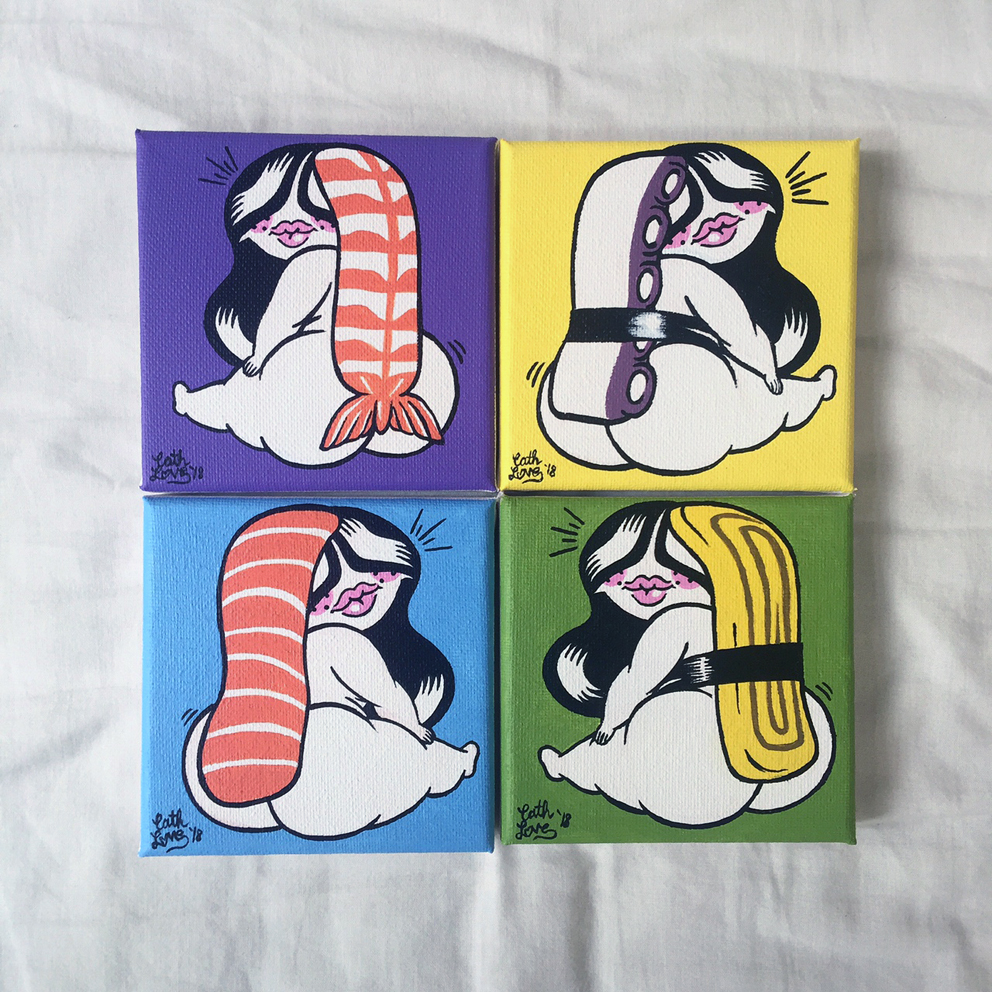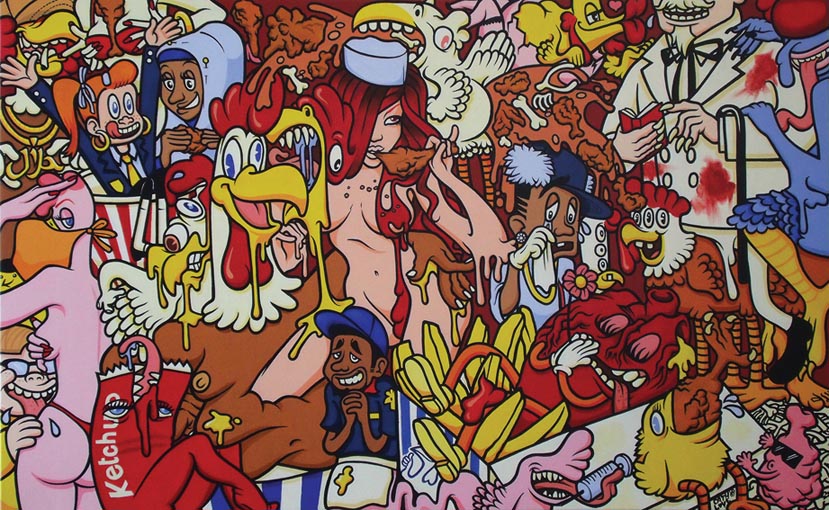Born in Bangkok and brought up in Hong Kong, with summers in the EU , Cath Love (Catherine Grossrieder) has combined her interests in manga, graffiti, hip hop and fine art. to create a unique style that perfectly summarizes the world of today.
Our interview with Catherine is below.
1. You come from a very diverse background and have talked about being a ‘3rd culture’ individual. What is your background and how does it influence your art?
My background is Thai and Swiss, but I grew up in Hong Kong. I’ve spent most of my life here. I went to a German International school, which boggles a lot of people’s minds, haha. Due to my upbringing, I’ve been exposed to a lot of international cartoons and comics. American, Belgian, French, Manga, Hong Kong and Thai ones, there are so many. I still don’t know where the fascination came from, but I was drawn to any and every cartoon and comic I could find. Also being mixed and getting different demands from both parents has shaped my character and humor. I always tried to create some middle ground going up, I didn’t really want to be like one or the other. So I can’t really answer those “do you feel more asian or western” questions. I’m just me, I guess, an enigma.
 2. That playfulness with identity, I can see in your creation Jeliboo. What inspired you to create Jeliboo, and through her, what audience are you trying to reach, empower or connect with?
2. That playfulness with identity, I can see in your creation Jeliboo. What inspired you to create Jeliboo, and through her, what audience are you trying to reach, empower or connect with?
I always enjoyed drawing curvy women, however I wanted to create one that was entirely my own. I omitted the eyes and instead worked with a heavy fringe, full lips and exaggerated curves, to see if I can use these elements for artistic expression. Also, I’d relate her to the bounciness and consistency of a marshmallow, for extra cuteness, haha. The body positivity and message of curve love came later, with admirers loving her for her feel-good vibes and positive disposition. Jeliboo and her sidekick bunny, Percy Fluffybottoms aka Fluffy B, are absolutely fun to draw and place in funny situations, where her curves sometimes become a playful obstacle.
 3. The “Fast Taste’ series which debuted at Over the Influence Gallery in Hong Kong. That series the imagery is also playful… but in a more sensational way. Was that series also about empowerment or was that more of a critique? How did it come about?
3. The “Fast Taste’ series which debuted at Over the Influence Gallery in Hong Kong. That series the imagery is also playful… but in a more sensational way. Was that series also about empowerment or was that more of a critique? How did it come about?
The theme Fast Taste came about from my 2 years living in London, namely Hackney, where there was an abundance of chicken shops and other fast food. It provided me with a much needed lift in inspiration. Due to my graffiti background, I enjoy drawing cartoon characters and with the influence of fast food and its stigma, it would be even gnarlier. So I started painting canvases filled with weird and wonderful creatures shaped by bad press surrounding fried chicken and fast food: genetic modification, health issues, heart disease, animal cruelty and so on. I’m not trying to express some sort of uncovering of the truth, but aim to portray my works in a satirical and fun light.

4. Fast Taste features many American brands and imagery. In the Era of Trump everything seems so over the top, and the sensationalism of him as president… makes it hard to take the reality of the situation seriously. I’m wondering (and this is a big question!) As someone who has worked with art and imagery that’s sensational, what advice or insight do you have into real life Sensationalists like Trump or Durante(Duterte?)? How should we view them and how can we critique them?
The works feature american traces due to fast food association with the US. Not just that, it is a satirical mockery of how the rest of the world sees the connection of comfort food and America. A lot of the chicken shops in London bear the typical blue, red and white colors and elements like stars and stripes, because they want to sell the “American taste”. I suppose this “American taste” extends into the rest of the world and other popular culture. For instance, we grew up watching american tv, listened to american music and wanted to sport the American lifestyle, because it was in fashion. It still very much is in fashion, just like it’s in fashion to vilify Trump, yet still willingly want to visit the United States. The Fast Taste works reflect a degree of hypocrisy: bashing the American life, but wanting the American life. Sure, Trump isn’t palatable, but not long ago, people were calling him billionaire maverick or boss, someone to aspire to. Trump is a businessman and showman at the end of the day and this sort of behaviour, despite abysmal, gets him in the spotlight. He’s not doing much different than what a lot of people in social media do. People love a villain, I guess.
 5. I really enjoy that you work in both the gallery and graffiti or tagging space. I’m wondering as we’ve seen more and more artists cross over between the two, what do you think these traditionally spaces can learn about each others cultures? How can we use both to remix the others culture?
5. I really enjoy that you work in both the gallery and graffiti or tagging space. I’m wondering as we’ve seen more and more artists cross over between the two, what do you think these traditionally spaces can learn about each others cultures? How can we use both to remix the others culture?
I think that there is a limit to graffiti in the fine art world. You can transfer ingredients of it to the fine art realm, but you cannot take the whole cookbook. So I like to separate the two genres, into more graffiti based art for smaller independent galleries and reserve my surreal paintings for the fine art ones.
6. Lastly, what book, artist and album are you enjoying recently?
I’m enjoying Gucci Mane’s “Mr. Davis” album, “The Incarnations” book by Susan Baker and I really like Tomoo Gokita, a Japanese artist.
All images were provided by Catherine Grossrieder, they remain property of Catherine Grossrieder
Contact Asia Art Tours today for more information on Catherine and the other amazing artists we work with.
To contact Catherine please visit: cathlove.com

